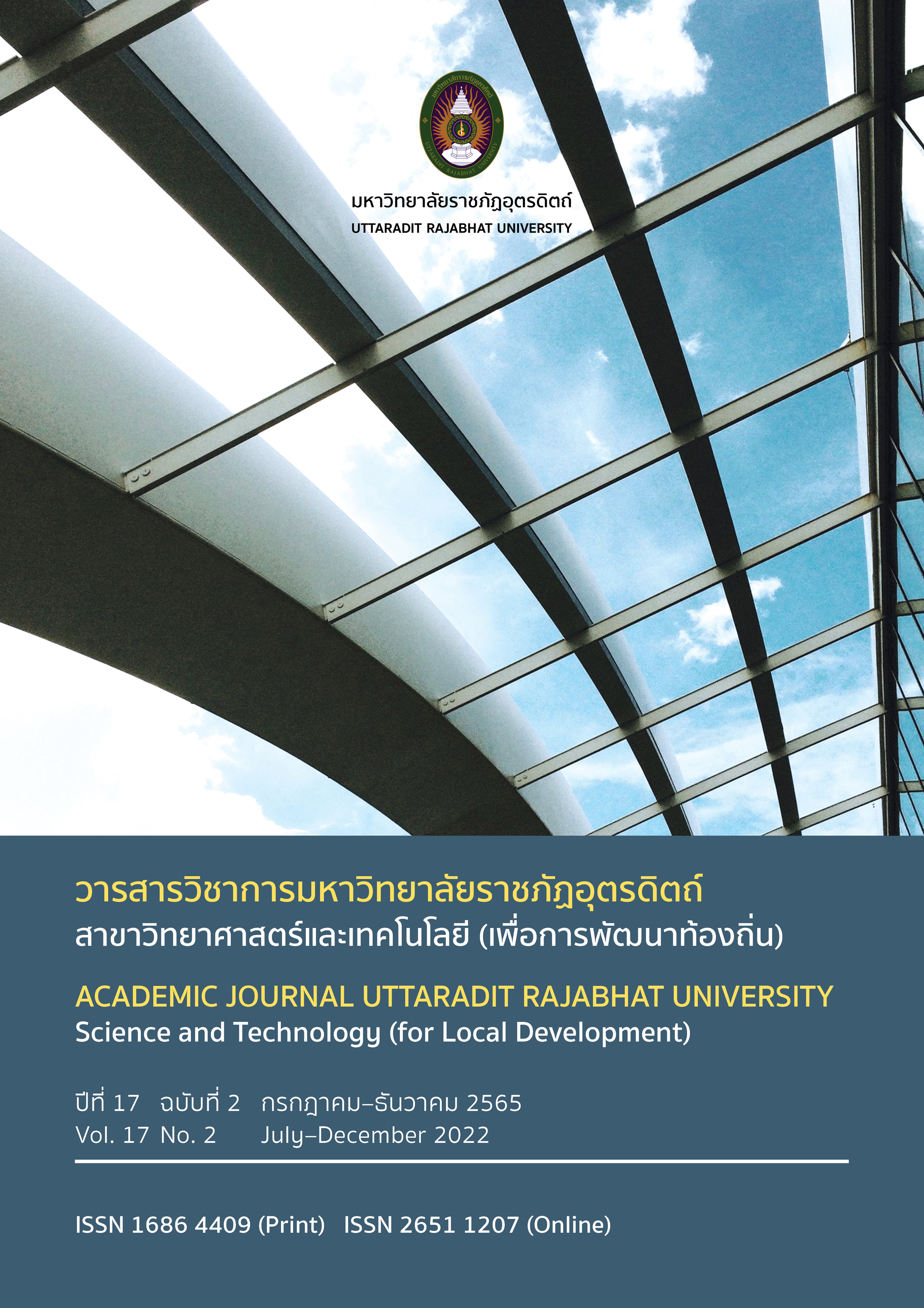ผลของอุณหภูมิในการอบต่อคุณค่าทางโภชนาการและลักษณะทางกายภาพของกากมันหมู
Main Article Content
บทคัดย่อ
งานวิจัยนี้มีวัตถุประสงค์เพื่อศึกษาผลของอุณหภูมิในการอบต่อคุณค่าทางโภชนาการและลักษณะทางกายภาพของกากมันหมู โดยใช้มันแข็งหมู ขนาด 3 5 เซนติเมตร บรรจุในถุงพลาสติก ขนาด 1 กิโลกรัม ต่อถุง เก็บที่อุณหภูมิต่ำกว่า -18 องศาเซลเซียส ผันแปรอุณหภูมิในการอบมันแข็งหมูที่ 150, 175 และ 200 องศาเซลเซียส เป็นเวลา 3 ชั่วโมง และวิเคราะห์ปริมาณพลังงานทั้งหมด ได้แก่ ความชื้น โปรตีน เถ้า ไขมัน คาร์โบไฮเดรท วอเตอร์แอคติวิตี วัดค่าสี CIE L*, a*, b* วัดค่าแรงเฉือน และพลังงานในการเคี้ยว ผลการวิจัย พบว่า เมื่ออุณหภูมิในการอบเพิ่มขึ้นทำให้ปริมาณไขมัน ค่าความสว่างของสี (L*) มีแนวโน้มลดลง ส่วนค่าสีแดง (a* value) มีแนวโน้มเพิ่มขึ้น (p<0.05) การอบที่อุณหภูมิ 200 องศาเซลเซียส เป็นเวลานาน 3 ชั่วโมง ทำให้ปริมาณเถ้าและปริมาณโปรตีนมีค่าสูงที่สุด การอบที่อุณหภูมิ 175 องศาเซลเซียส ทำให้ค่าความเป็นสีเหลือง (b* value) และพลังงานในการเคี้ยวมีค่าสูงที่สุด คือ 34.21 และ 17.67 นิวตันต่อมิลลิเมตร ตามลำดับ (p<0.05) อุณหภูมิที่เหมาะสมของการอบกากมันหมูคือ 175 องศาเซลเซียส นาน 3 ชั่วโมง ทำให้กากมันหมูที่มีค่าความเป็นสีเหลืองมากที่สุด ทั้งนี้ สีเหลืองของผลิตภัณฑ์ดังกล่าวเป็นปัจจัยสำคัญของผลิตภัณฑ์กากมันหมูที่ผู้บริโภคต้องการ
Downloads
Article Details

อนุญาตภายใต้เงื่อนไข Creative Commons Attribution-NonCommercial-NoDerivatives 4.0 International License.
เอกสารอ้างอิง
กรุงเทพธุรกิจออนไลน์. (2563, 21 สิงหาคม). รู้ข้อดีข้อเสียก่อนกิน “น้ำมันหมู” มีคุณค่าทางโภชนาการดีจริงหรือ”. กรุงเทพธุรกิจ มีเดีย จำกัด. https://www.bangkokbiznews.com/lifestyle/894668
ประวิทย์ สันติวัฒนา และธิดา สิริสุขพรชัย. (2559). ผลของการใช้แป้งรำข้าวที่ผ่านการสกัดน้ำมันทดแทนเนื้อหมูในผลิตภัณฑ์หมูบดทอดและคุณภาพของน้ำมันที่ใช้ทอด. วารสารวิทยาศาสตร์และเทคโนโลยี, 24(3), 432-442. https://doi.org/10.14456/tstj.2016.35
ภูมิใจ สอาดโฉม และธนิต สวัสดิ์เสวี. (2557). การอบแห้งเนื้อหมูบดแผ่นด้วยเทคนิคสุญญากาศร่วมกับรังสีอินฟราเรดไกล. วารสารวิชาการ คณะเทคโนโลยีอุตสาหกรรม มหาวิทยาลัยราชภัฏลำปาง, 7(1), 83-97.
สมาคมผู้เลี้ยงสุกรแห่งชาติ. (2565). สถานการณ์อุตสาหกรรมสุกรและแนวโน้มปี 2565. https://www.swinethailand.com/
AOAC. International. (2019). Official methods of analysis of AOAC international (21sted). The Association of Official Analysis Chemists.
Baek, Ki Ho., Utama, Dicky Tri., Lee, Seung Gyu., An, Byoung Ki., & Lee, Sung Ki. (2016). Effects of replacing pork back fat with canola and flaxseed oils on physicochemical properties of emulsion sausages from spent layer meat. Asian-Australasian Journal of Animal Science, 29(6), 865-871. https://doi.org/10.5713/ajas.15.1050
Barretto, A. C. S., Pacheco, M. T. B., & Pollonio, M. A. R. (2015). Effect of the addition of wheat fiber and partial pork back fat on the chemical composition, texture and sensory property of low-fat bologna sausage containing inulin and oat fiber. Food Science and Technology, 35(1), 100-107. https://doi.org/10.1590/1678-457X.6496
Glorieux, S., Steen, L., Van de Walle, D., Dewettinck, K., Foubert, I., & Fraeye, I. (2018). Effect of Meat Type, Animal Fat Type, and Cooking Temperature on Microstructural and Macroscopic Properties of Cooked Sausages. Food and Bioprocess Technology, 12(1), 16–26. https://doi.org/10.1007/s11947-018-2190-6
Kim, Gye-Woong., & Kim, Hack-Youn. (2017). Effects of Carcass Weight and Back-fat Thickness on Carcass Properties of Korean Native Pigs. Korean Journal for Food Science of Animal Resources, 37(3), 385-391. https://doi.org/10.5851/kosfa.2017.37.3.385
Küçüközet, A. O., & Uslu, M. K. (2018). Cooking loss, tenderness, and sensory evaluation of chicken meat roasted after wrapping with edible films. Food Science and Technology International, 24(7), 1-9. https://doi.org/10.1177/1082013218776540
Park, G. B., Moon, S. S., Ko, Y. D, Ha, J. K., Lee, J. G., Chang, H. H, & Joo. S. T. (2002). Influence of slaughter weight and sex on yield and quality grades of Hanwoo (Korean native cattle) carcasses. Journal of Animal Science, 80(1), 129-136. https://doi.org/10.2527/2002.801129x
Powell, T. H., Dikeman, M. E., & Hunt, M. C. (2000). Tenderness and collagen composition of beef semitendinosus roasts cooked by conventional convective cooking and modeled, multi-stage, convective cooking. Meat Science, 55(4), 421-425. https://doi.org/10.1016/s0309-1740(99)00171-0
Wood, J. D., Enser, M., Whittington, F. M., Moncrieff. C. B., & Kempster, A. J. (1989). Backfat composition in pigs: Differences between fat thickness groups and sexes. Livestock Production Science, 22(3-4), 351-362. https://doi.org/10.1016/0301-6226(89)90066-3


